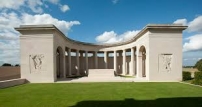| First Name: | Frederick Cecil | Last Name: | JACKSON | |
|---|---|---|---|---|
| Date of Death: | 20/11/1917 | Lived/Born In: | Nunhead | |
| Rank: | Rifleman | Unit: | Rifle Brigade11 | |
| Memorial Site: | 1. Brockley School 2. Brockley, St Peter 3. Royal Courts of Justice 4. Cambrai Memorial, Louverval, | |||
Current Information:Age-18 Born-Peckham
The Battle of Cambrai This was a major British offensive on the Western Front that was launched on 20th November, 1917 and lasted through to the beginning of December. As the name suggests it was an attack towards the city of Cambrai and the important German railhead there, which it was hoped would be captured. The battle was notable for two things: the massed use of tanks for the first time and the success of the first day’s fighting when the formidable Hindenburg Line was breached and gains of five miles were made in places. In celebration the church bells throughout Britain were rung. However this success was short lived. The tanks were not reliable and the German defence stiffened as the fighting progressed and when they counter attacked in force on 30th November, the British came under so much pressure that they were forced to withdraw from many of the positions they had captured earlier on. Both sides suffered around 45,000 casualties during the course of the fighting. On the opening day of Cambrai, 20th November, 1917, 12th Division attacked at 6.20am, on the extreme right of the battle front and after they had captured their first objective they formed a defensive flank to the south east. At 9am, 59 Brigade, the reserve brig of 20th Division, moved forward down the valley from La Vacquerie to extend this defensive flank along the Bonavis Ridge. They were led by the 11th Rifle Brigade battalion with 10th Rifle Brigade and 10th King’s Royal Rifle Corps following. At first they got involved in the fighting for the second objective but by 10.30am were able to move clear of the Brown Line. The right hand company of 11th Rifle Brigade needed help from a tank to deal with a machine-gun before reaching Rues Vertes, on the St Quentin canal opposite Masnières but the enemy still held Masnières in force and although 11th Rifle Brigade scouts managed to get to the other side of the canal, the crossing could not be forced by the rest of the battalion. 10th Rifle Brigade followed on the right rear and wheeled to take up their allotted position on the Bonavis Ridge and made touch with 11th Rifle Brigade in les Rues Vertes. The left hand company of 11th Rifle Brigade met opposition as they moved towards Marcoing Copse but after a sharp fight they had captured 150 prisoners. Further to their left two companies of 10th King’s Royal Rifle Corps also met opposition as they moved up but then tanks arrived and helped clear Marcoing and 200 more prisoners were captured. In the afternoon 11th Rifle Brigade withdrew its detachment from les Rues Vertes and established posts facing east from the canal up the slope of the Bonavis Ridge. That evening they pushed forward towards Crèvecoeur and secured Mon Plaisir Farm bridge and the lock crossing without fighting. A patrol attempted to enter Crèvecoeur but were prevented by heavy fire. Among the casualties sustained by 11th Rifle Brigade on 20th November was Frederick Jackson who was one of more than twenty men from the battalion who were killed in action. |
||||
| « Back to Search Results | ||||
| If you think any of the information shown here is incorrect, Click Here to submit your amends and comments | ||||




